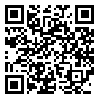Volume 6, Issue 4 (Summer 2021)
Health in Emergencies and Disasters Quarterly 2021, 6(4): 225-234 |
Back to browse issues page
Download citation:
BibTeX | RIS | EndNote | Medlars | ProCite | Reference Manager | RefWorks
Send citation to:



BibTeX | RIS | EndNote | Medlars | ProCite | Reference Manager | RefWorks
Send citation to:
Azadeh M R, Parvaresh Massoud M, Gaini M, Hemta A. Comparative Study of Road Traffic Accident Victims Transferred by Air and Ground Emergency to Shahid Beheshti Medical Center in Qom City, Iran, 2015-2018. Health in Emergencies and Disasters Quarterly 2021; 6 (4) :225-234
URL: http://hdq.uswr.ac.ir/article-1-351-en.html
URL: http://hdq.uswr.ac.ir/article-1-351-en.html
1- Department of Nursing, School of Nursing and Midwifery, Qom University of Medical Sciences, Qom, Iran., Qom University of Medical Sciences, Qom, Iran
2- Department of Nursing, School of Nursing and Midwifery, Qom University of Medical Sciences, Qom, Iran. ,mparvaresh@muq.ac.ir
3- Pediatric Clinical Research Development Unit, Qom University of Medical Sciences, Qom, Iran., Qom University of Medical Sciences, Qom, Iran
2- Department of Nursing, School of Nursing and Midwifery, Qom University of Medical Sciences, Qom, Iran. ,
3- Pediatric Clinical Research Development Unit, Qom University of Medical Sciences, Qom, Iran., Qom University of Medical Sciences, Qom, Iran
Abstract: (3987 Views)
Background: Prehospital emergency department provides land, air, boat, and rail ambulance care. This study aimed to compare the situation of air and ground emergency casualties in road traffic accidents transferred to Shahid Beheshti Medical Center in Qom City, Iran, 2015-2018.
Materials and Methods: The present study is a retrospective descriptive-analytical study. All road traffic accident victims transferred to Shahid Beheshti Medical Center in Qom by prehospital emergency land or air staff from 2015 to 2018 at 6 to 20 o’clock were included in this study (census method). The exclusion criteria included burns, death, transmission during cardiopulmonary resuscitation or by urban ambulances, and information deficiencies. We used a researcher-made checklist to examine victims’ age, sex, type of transmission, type of accident, type of trauma, distance, initial vital signs, time intervals, and day of the accident. SPSS software version 16 was used to analyze the data. Data were compared in two groups with the t test and the Chi-square test.
Results: A total of 2057 casualties were included in the study: 566 casualties were transferred by air emergency and 1491 by ground emergency. The mean age of air emergency casualties was significantly lower than the ground emergency (P=0.008). Trauma to the neck, chest, abdomen and lower back was significantly higher in air emergency casualties, but hand and foot trauma were more common in ground emergency casualties. Most air missions took place on holidays or weekends, while most ground missions were done during weekdays (P<0.001). The mean distance of the air emergency missions was more than Beheshti Medical Center (P<0.001). Compared with ground emergency casualties, air emergency casualties had average systolic blood pressure, lower level of consciousness, and higher heart rate and respiration (P<0.001). The mean duration of transfer from the accident scene to the medical center in the air emergency was significantly shorter (P<0.001).
Conclusion: Air emergency casualties were usually accompanied by more critical vital signs and severe injuries to the neck, chest, abdomen, and back. This study can provide clinical triage criteria that focus on key environmental factors and reduced transport time. Further studies are needed to investigate the consequences of traffic accident casualties at the medical center to determine which subgroups will benefit most from using air emergency.
Materials and Methods: The present study is a retrospective descriptive-analytical study. All road traffic accident victims transferred to Shahid Beheshti Medical Center in Qom by prehospital emergency land or air staff from 2015 to 2018 at 6 to 20 o’clock were included in this study (census method). The exclusion criteria included burns, death, transmission during cardiopulmonary resuscitation or by urban ambulances, and information deficiencies. We used a researcher-made checklist to examine victims’ age, sex, type of transmission, type of accident, type of trauma, distance, initial vital signs, time intervals, and day of the accident. SPSS software version 16 was used to analyze the data. Data were compared in two groups with the t test and the Chi-square test.
Results: A total of 2057 casualties were included in the study: 566 casualties were transferred by air emergency and 1491 by ground emergency. The mean age of air emergency casualties was significantly lower than the ground emergency (P=0.008). Trauma to the neck, chest, abdomen and lower back was significantly higher in air emergency casualties, but hand and foot trauma were more common in ground emergency casualties. Most air missions took place on holidays or weekends, while most ground missions were done during weekdays (P<0.001). The mean distance of the air emergency missions was more than Beheshti Medical Center (P<0.001). Compared with ground emergency casualties, air emergency casualties had average systolic blood pressure, lower level of consciousness, and higher heart rate and respiration (P<0.001). The mean duration of transfer from the accident scene to the medical center in the air emergency was significantly shorter (P<0.001).
Conclusion: Air emergency casualties were usually accompanied by more critical vital signs and severe injuries to the neck, chest, abdomen, and back. This study can provide clinical triage criteria that focus on key environmental factors and reduced transport time. Further studies are needed to investigate the consequences of traffic accident casualties at the medical center to determine which subgroups will benefit most from using air emergency.
Type of article: Research |
Subject:
General
Received: 2021/03/3 | Accepted: 2021/05/23 | Published: 2021/07/1
Received: 2021/03/3 | Accepted: 2021/05/23 | Published: 2021/07/1
Send email to the article author
| Rights and permissions | |
 |
This work is licensed under a Creative Commons Attribution-NonCommercial 4.0 International License. |








